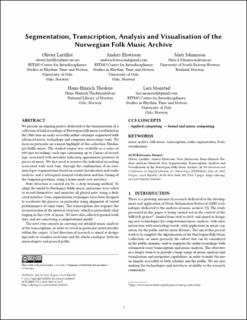| dc.contributor.author | Lartillot, Olivier | |
| dc.contributor.author | Elovsson, Anders | |
| dc.contributor.author | Johansson, Mats Sigvard | |
| dc.contributor.author | Thedens, Hans-Hinrich | |
| dc.date.accessioned | 2022-08-31T08:49:33Z | |
| dc.date.available | 2022-08-31T08:49:33Z | |
| dc.date.created | 2022-08-29T21:13:20Z | |
| dc.date.issued | 2022 | |
| dc.identifier.citation | Lartillot, O., Elowsson, A., Johansson, M., Thedens, H.-H. & Monstad, L. (2022, 28. juli). Segmentation, Transcription, Analysis and Visualisation of the Norwegian Folk Music Archive [Paperpresentasjon]. Proceedings of the 9th International Conference on Digital Libraries for Musicology, Prague, Czech Republic. | en_US |
| dc.identifier.isbn | 978-1-4503-9668-4 | |
| dc.identifier.uri | https://hdl.handle.net/11250/3014638 | |
| dc.description.abstract | We present an ongoing project dedicated to the transmutation of a collection of field recordings of Norwegian folk music established in the 1960s into an easily accessible online catalogue augmented with advanced music technology and computer musicology tools. We focus in particular on a major highlight of this collection: Hardanger fiddle music. The studied corpus was available as a series of 600 tape recordings, each tape containing up to 2 hours of recordings, associated with metadata indicating approximate positions of pieces of music. We first need to retrieve the individual recording associated with each tune, through the combination of an automated pre-segmentation based on sound classification and audio analysis, and a subsequent manual verification and fine-tuning of the temporal positions, using a home-made user interface.
Note detection is carried out by a deep learning method. To adapt the model to Hardanger fiddle music, musicians were asked to record themselves and annotate all played note, using a dedicated interface. Data augmentation techniques have been designed to accelerate the process, in particular using alignment of varied performances of same tunes. The transcription also requires the reconstruction of the metrical structure, which is particularly challenging in this style of music. We have also collected ground-truth data, and are conceiving a computational model.
The next step consists in carrying out detailed music analysis of the transcriptions, in order to reveal in particular intertextuality within the corpus. A last direction of research is aimed at designing tools to visualise each tune and the whole catalogue, both for musicologists and general public. | en_US |
| dc.language.iso | eng | en_US |
| dc.relation.ispartof | DLfM '22: 9th International Conference on Digital Libraries for Musicology | |
| dc.relation.uri | https://dl.acm.org/doi/10.1145/3543882.3543883 | |
| dc.rights | Navngivelse 4.0 Internasjonal | * |
| dc.rights.uri | http://creativecommons.org/licenses/by/4.0/deed.no | * |
| dc.title | Segmentation, Transcription, Analysis and Visualisation of the Norwegian Folk Music Archive | en_US |
| dc.type | Chapter | en_US |
| dc.description.version | publishedVersion | en_US |
| dc.rights.holder | © 2022 Copyright held by the owner/author(s). | en_US |
| dc.source.pagenumber | 1-9 | en_US |
| dc.identifier.doi | https://doi.org/10.1145/3543882.3543883 | |
| dc.identifier.cristin | 2046946 | |
| dc.relation.project | Norges forskningsråd: 262762 | en_US |
| dc.relation.project | Norges forskningsråd: 287152 | en_US |
| dc.relation.project | Sigma2: NN9750K | en_US |
| cristin.ispublished | true | |
| cristin.fulltext | original | |
| cristin.qualitycode | 1 | |

